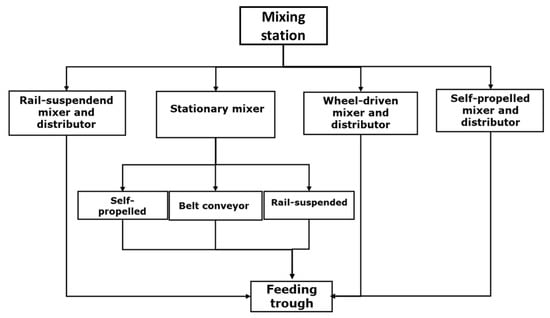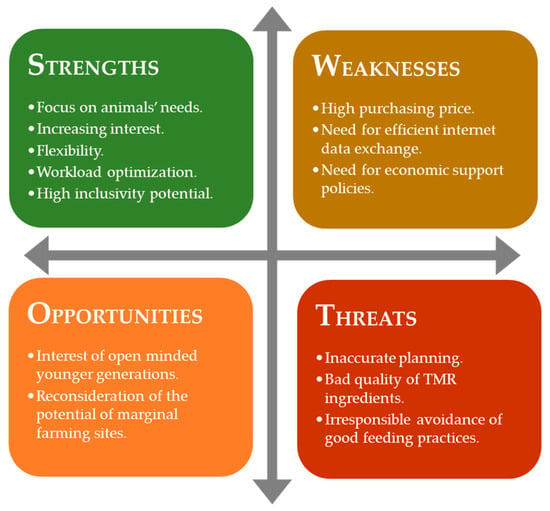Livestock farming is experiencing a significant shift towards automation to reduce the many repetitive tasks requiring little skills and high workloads. For farmers, automatic feeding systems for ruminants can be an excellent way to reduce their daily workload and improve animal welfare and production quality. Studies have demonstrated that adopting automatic feeding systems leads to lower energy requirements, lower feed waste, and improved animal welfare, which unequivocally aligns with the farmers' perspective. However, to maximize the flexibility of the feeding robots and reap the benefits, thorough economic and structural planning that considers all of the farming site's features is necessary. Additionally, automatic feeding systems can help involve younger generations in animal farming and increase inclusivity, which may foster female entrepreneurship, all while maintaining good feeding practices.
- total mixed ration
- TMR
- AFS
- automation
- beef
- Ruminants
- Dairy
1. Introduction
The TMR improves ruminants' efficiency and health status [12] and promotes better feed reception, particularly when frequently administered to animals. However, it is essential that operators take proper precautions, such as adding water during mixing, and allow for adequate mixing times [13][14][15][13,14,15]. This is particularly important regarding TMR particle size and consistency, which are limiting factors that should be considered closely. Studies have shown that TMR's particle size and consistency can significantly impact ruminant health and efficiency [16][17][16,17].
2. Automatic Feeding Pushing and Administering Technological Solutions
Feeding cattle on livestock farms is a labor-intensive operation. Automatic feed pushers (AFPs) are the first tools developed for the recurring pushing and approaching of the feed that the animals move away from the manger when they sort the TMR against long forage particles in favor of the smaller, high-starch grain particles [18][53]. AFPs warrant constant cattle feed availability in the manger between TMR distributions. AFS design aims to reduce workforce use and improve work flexibility. Their introduction dates to the end of the 20th and the beginning of the 21st century, first in the Northern European countries and then in Italy (since 2013, mainly in the Northern Italian regions) [19][54]. However, their versatility has caused them to go far beyond the initial concept, making them complementary to the well-consolidated chopping–mixing wagon technology in both milk and meat production and a wide range of farming situations (e.g., farms in mountainous areas or aimed at the protected designation of origin productions) [20][21][55,56]. The systems currently on offer differ in their mode of operation and increasing complexity of technological level; ration preparation and delivery may be carried out in a stationary mixer, which feeds ration-delivering wagons, up to fully automatic systems that carry out all of the operations necessary to prepare the TMR autonomously.-
Stage I: machinery whose automation refers specifically to TMR shredding, mixing, and distribution (several times a day). They commonly rely on a stationary mixer that operators fill daily with each ingredient of the TMR from bunker silos either manually or using suitable loading machines.
-
Stage II: compared to Stage I machinery, the automation extends to the initial filling operation. TMR ingredients can either be loaded automatically in a stationary mixer, which facilitates mixing and shredding and fills the delivery wagons, or stored in a mixing station. Here, mechanical systems load them into auger-equipped wagons that mix the TMR before proceeding with the ration distribution.
-
Stage III: the TMR preparation is fully automated. The AFS autonomously provides load mixing–distributing wagons with each ration component directly from bunker silos without human intervention.

3. What Farmers Perceive about AFSs
4. Cattle Feeding Precision by Automatic Feeding Systems
4.1. Economic Assessment
Reducing production costs, the difficulty in finding specialized personnel, and the increasing size of herds have driven the development and diffusion of specific automated solutions in the dairy and beef sector. In particular, from a technological point of view, automatic concentrate dispensers and milking robots (AMSs) have been used for several years, while the AFS has entered the market only recently. Concerning the latter, the reasons for their success among breeders can be explained by (i) the high amount of time spent preparing and distributing the feed ration, (ii) the need to prepare a balanced and quality ration to optimize the cows’ production performance, and (iii) the possibility of feeding the ration more frequently than once/twice a day, to provide animals with fresh feed [34][80]. Increasing the feeding frequency increases the visits to the feeding trough over 24 h; this leads to longer feeding times and increased dry matter intake, with positive effects on cow health and production [35][81]. However, the adoption of an AFS results not only in an increased number of animal visits to the feeding trough but also considerably affects the organization of the daily workload, combining the reduction in labor requirements with an improvement in the quality of work if compared to the current technique based on the use of self-propelled or trailed mixing wagons. Bisaglia et al. [36][82] and Pezzuolo et al. [30][75] have shown a 50–60% reduction in the time needed to produce the total mixed ration (TMR) by switching from a conventional system consisting of a tractor-coupled mixing wagon to a stage II AFS equipped with a stationary chopping–mixing wagon positioned in the kitchen room and a rail-suspended distributor wagon.4.2. Animal Welfare
AFSs improve feed administration procedures, animal health, and animal welfare [37][38][88,89]. The human–animal relationship benefits livestock; however, there might be working conditions causing it to be even more damaging for the animals [39][90]. In such situations, using an AFS is potentially beneficial because it reduces the interactions between cattle and the stockperson. The desirable management of the feed bunk decreases the feeding competition, which results in negative animal interactions (e.g., pushing, head butting). In particular, the frequent passage of wagons suggests to animals that there is continuous availability of feed, inhibiting the aggressiveness of dominant animals and relaxing the submissive ones, with a subsequent increase in animals’ voluntary ingestion over 24 h [38][89]. Schneider et al. [40][91] assessed some parameters of fattening bulls fed with an AFS (e.g., body condition score, individual behavioral observations, and carcass weights), pointing out the significance of providing animals with a TMR six times in 24 h. Assessing cattle behavior involves observing several activities at different moments of the day (e.g., when resting in cubicles, milking parlor, and watering places). Concerning the feeding stage specifically, Brito et al. [38][89] recognized a dual role of the AFSs: firstly, the AFSs improve dairy cattle welfare; secondly, the AFSs can also record many animal behaviors according to Foris et al. [41][92], who found the AFSs helpful to assess the dominance relationship in dairy cattle. To ensure adequate access to the feed and to prevent the animals from competing with each other, guaranteeing a desirable ratio between herd size and the feed bunk length is also fundamental. In addition, an optimal feed bunk per head is strategic to ensure a good animal welfare standard. However, the kind of feed bunk, the type of feeding, the feed distribution system, and the feed management are among the factors that, in turn, affect the optimal number of available places [42][93]. Currently, there are two types of feed bunks: (i) those with delimited places, equipped with self-capture systems (either with or without anti-suffocation systems), and (ii) those with two horizontal tubes, commonly used for fattening cattle. The first one, albeit of simple technology, allows routine operations on dairy cows and, therefore, requires the number of available feed bunks to match the number of housed animals [43][94]. Lactating cows, characterized by a longer productive life, require careful attention and feeding, which the single manger ensures. On the other hand, the shorter housing of fattening cattle does not require obligatory spaces in the feed bunk as treatments on a single fattening animal do not occur frequently. According to our best knowledge, on the one hand, AFSs are rarely used in beef systems, despite their technology meeting the needs of fattening cattle farms; on the other, their occurrence in dairy cattle farms is becoming quite widespread, although not ubiquitous [28][73]. Concerning feeding administration, in the case of simultaneous feeding, the number of optimum places should match 100% of the animals because all of them go to the feed bunk simultaneously at the time of distribution. It lowers to 70% of the reared animals in the case of continuous feeding because the barn’s design considers the presence of a feeder that makes the feed available 18 h per day, causing animals to alternate to access the feed bunk. The feed distribution system and management play a crucial role as feeding is a predominant behavior in dairy cattle; dairy cows spend 3 to 5 h day−1 feeding, consuming 9 to 14 meals daily [44][95]. Traditionally, housed dairy cows are provided with fresh feed twice or only once daily, mechanically. In this case, animals receive small quantities of fresh feed several times daily. Distributing feed in several daily meals limits competition at the feed bunk and improves the digestive function of each head [45][96], confirming the findings of Robles et al. [46][97], who highlighted that a high feeding frequency improves the ruminal condition and the digestive performances [46][97]. Effectively and carefully managing the feed at the feed bunk is a principal issue. Dairy cows tend to discard/sort feed in search of the most palatable ingredients, pushing it away from the feeder [18][53]. For this reason, it is necessary to push it closer again. When performed automatically by feed-pusher-type robotic units, the increase in the daily feed approach has been associated with increased milk yield [47][98]. Studying farms equipped with automatic milking systems, Siewert et al. [48][99], Deming et al. [49][100], and King et al. [50][101] highlighted the benefits of increased feed-pushing frequency, which resulted from improved feed access, decreased sorting, and less time spent searching for feed and increased time spent lying down, which all have positive effects on milk yield.5. Conclusions
AFSs represent the evolution of the TMR preparation technology with subsequent advantages regarding workload, animal nutrition, and animal welfare optimization. The market offers farmers quite a wide choice of machinery that can adapt to the animals’ needs and the constraints resulting from the farming site’s peculiarities. In particular, the chosen feeding system should fully match the farm’s needs, being able to cope with the needs of the various groups of animals (all must receive the same amount of feed; the system components should guarantee adequate autonomy) and the operators’ needs (suitable loading and unloading solutions; provision of an alternative feeding method in case of equipment failure). Concerning the cow shed, the AFS arrangement should match the farm work cycles, and its placement (external, eaves side, or gable side development) should consider the path the wagons follow and the need for protection that the kitchen room requires to prevent TMR components from deterioration. Already in the planning phase, the paving of the barn needs accurate consideration. Whether newly built or not, the paving of the shed must have an appropriate design (suitable slope, smooth surface, silage effluent, and cleaning water draining systems). The building structure (particularly its load-bearing capacity) and the feed alley width should match the characteristics of the AFS to achieve maximum efficiency from the machine. AFSs are easy to use, making them fundamental for the involvement of younger generations in animal farming and increasing the inclusivity of such an activity with the subsequent fostering of female entrepreneurship. However, there are also some warnings: running an AFS does not free farmers from complying with good feeding procedures because the ingredients’ quality and the management’s appropriateness affect the feed quality and animal production (Figure 2). Healthy animals fed balanced diets and provided with abundant supplies of fresh water are the most productive, the most profitable to the farmer, and the most efficient users of nutrients.
